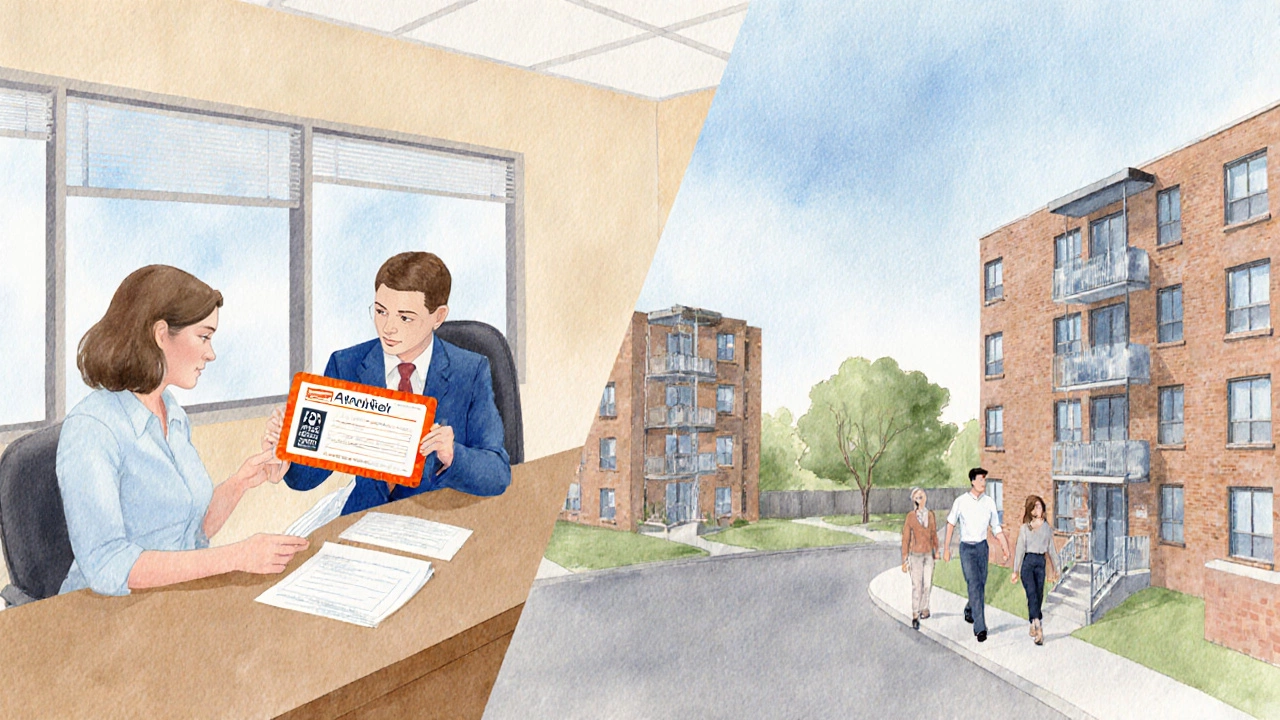Affordable Housing Eligibility Calculator
Calculate Your Eligibility
Eligibility Results
Enter your household size and income to see eligibility results.
How This Works
Based on HUD's 2024 guidelines, this calculator compares your income to the Area Median Income (AMI) limits for the Continental U.S.
Most affordable housing programs use 50%, 80%, or 120% of AMI as eligibility thresholds.
Important: AMI varies by location - check your local housing authority for area-specific limits.
When you hear affordable housing eligibility, you’re probably wondering what numbers, paperwork, or rules decide if you can get a rent‑controlled apartment or a voucher. In plain language, affordable housing is a type of housing that is priced so that households earning a certain share of the local median income won’t spend more than about 30% of their earnings on rent or mortgage.
Affordable Housing is a housing category that limits costs based on income thresholds set by the U.S. Department of Housing and Urban Development (HUD). It includes public‑housing units, privately owned apartments that receive tax credits, and voucher‑based programs that help families pay market rent.
Core Eligibility Pillars
- Income limits: Your household’s gross annual income must fall at or below a set percentage of the Area Median Income (AMI). Most programs use 50% or 80% of AMI as the cut‑off, but some local agencies stretch the line to 120% for “moderately‑priced” units.
- Household size: HUD tables adjust income limits for each additional family member. A single adult qualifies at a lower dollar amount than a family of four because the cost of living rises with each person.
- Citizenship and residency: At least one adult must be a U.S. citizen or have eligible immigration status (e.g., lawful permanent resident, refugee, asylee). Some state‑run programs also accept undocumented residents, but the federal rules are stricter.
- Asset limits: A few programs, especially those aimed at the deepest‑poverty tier, cap countable assets (cash, stocks, vehicles) at a few thousand dollars. Most voucher programs focus solely on income.
Key Federal Programs and How They Define “Qualified”
Understanding the big players helps you see where the eligibility rules differ.
Section 8 Housing Choice Voucher is a federal subsidy that pays a portion of a household’s rent in the private market. It’s administered locally by public housing agencies (PHAs) and follows HUD’s income‑limit tables.
- Section 8 - Tenant‑Based Vouchers: Families apply to their local PHA. The agency checks income, family composition, and eligibility categories (e.g., homelessness, domestic violence). If approved, the voucher follows the family to any qualifying unit.
- Section 8 - Project‑Based Vouchers: The subsidy is attached to a specific building. Tenants must meet the same income test, but the unit’s rent is already set within the program’s limits.
- Public Housing: Owned and operated by PHAs. Units are reserved for low‑income families, seniors, and persons with disabilities. Income caps are usually 30% of AMI, making it the most restrictive tier.
- Low‑Income Housing Tax Credit (LIHTC) properties: Private developers receive tax credits in exchange for reserving a portion of units for low‑income residents (typically 40% at 60% of AMI, or 20% at 50% of AMI). Eligibility mirrors HUD’s tables.
How HUD Calculates Income Limits
All the numbers you’ll see on eligibility charts come from the same source: the HUD Annual Income Limits report.
- HUD gathers median family income data for each metropolitan area and county.
- It creates the Area Median Income (AMI) figure - the midpoint of all reported incomes.
- Each program picks a percentage of AMI as its cut‑off. For example, a 50% AMI limit means a family must earn no more than half the median.
- The agency adjusts the AMI for household size using a standard formula (add roughly 5‑7% per additional member).
Because AMI changes each year with inflation and local wage trends, the dollar thresholds you see on a website today might be outdated by next spring. Always verify the latest figure on your local PHA’s site or HUD’s “Income Limits” page.

State and Local Tweaks
While the federal government sets the baseline, states and cities often add their own layers.
- California’s “Medi‑Cal” rule: The Golden State caps rent‑burden at 30% and uses a higher 60% AMI threshold for many of its inclusionary housing projects.
- New York’s “Income‑Based Rent” (IBR): Public housing residents pay 30% of income, but a separate “Family Homelessness Prevention” program allows families up to 80% of AMI to qualify for rental assistance.
- Texas emergency voucher pilots: Some counties temporarily raise the income limit to 120% of AMI during disasters, enabling displaced families to stay in market units.
Always check your municipality’s affordable‑housing office for special programs, especially those targeting seniors, veterans, or people with disabilities.
Step‑by‑Step: Applying for Assistance
- Gather documentation: Recent pay stubs, tax returns, bank statements, proof of citizenship or lawful presence, and a list of household members with birth dates.
- Locate your local public housing agency (PHA): Use HUD’s agency finder (search by zip code). Most PHAs have an online portal where you can start an application.
- Submit the application: Fill out the form accurately; a common mistake is forgetting to list part‑time income or alimony, which can push you over the limit.
- Wait for verification: The PHA will cross‑check your income, run a background check, and may request additional proof.
- Receive a voucher or placement notice: If you get a Section 8 voucher, you’ll have a set amount of “payment standard” that the PHA will pay toward rent. If you’re placed in public housing, you’ll be given a unit offer.
- Sign the lease and comply with recertification: Income is re‑verified annually. Keep records handy; a sudden raise can mean you lose the subsidy.
Common Pitfalls and Pro Tips
- Don’t assume a higher income disqualifies you from every program. Some cities run “moderately‑priced” units at 80% or 120% of AMI, which can still be a good deal.
- Understand the difference between “gross” and “net” income. HUD uses gross (pre‑tax) figures; if you have large deductions, you might still qualify.
- Watch the waiting list. Public housing often has years‑long lists. Keep your application current and ask the PHA about “reverse‑waiting‑list” options for families in crisis.
- Keep your household composition up to date. Adding a child or adult changes your income limit automatically.
- Leverage local non‑profits. Many nonprofits run pre‑screening services that help you gather the right paperwork before you hit the PHA.

Quick Reference: Income Limits by Household Size (2024)
| Household Size | Annual Income Limit | Monthly Income Limit |
|---|---|---|
| 1 | $24,300 | $2,025 |
| 2 | $27,800 | $2,317 |
| 3 | $31,300 | $2,608 |
| 4 | $34,800 | $2,900 |
| 5 | $38,300 | $3,192 |
| 6 | $41,800 | $3,483 |
| 7 | $45,300 | $3,775 |
| 8 | $48,800 | $4,067 |
These numbers are a baseline. If you live in a high‑cost metro area like San Francisco or New York, the local AMI is higher, which pushes the dollar limits upward.
Frequently Asked Questions
Frequently Asked Questions
What income percentage of AMI qualifies for most affordable‑housing programs?
Most federal programs set the bar at 50% of the Area Median Income, while many state or city initiatives use 80% or even 120% for moderately priced units.
Can I apply for both a Section 8 voucher and public housing simultaneously?
Yes. Applying to multiple programs doesn’t disqualify you, but you can only receive assistance from one program at a time. If you win a voucher, the public‑housing waiting list may stay open, but you’ll be taken off if you accept the voucher.
Do assets like a car or savings affect eligibility?
Only a few deep‑poverty programs count assets, usually capping them at $2,500 for a single adult and $5,000 for a family. Most voucher programs focus solely on income.
How often do I have to recertify my income?
Typically once a year. Some PHAs will request documentation every six months if your household income is near the program’s limit.
I’m a veteran. Are there special programs for me?
Yes. The Veterans Affairs Supportive Housing (VASH) program combines HUD vouchers with VA case management, offering priority placement and sometimes higher income limits for veterans.

